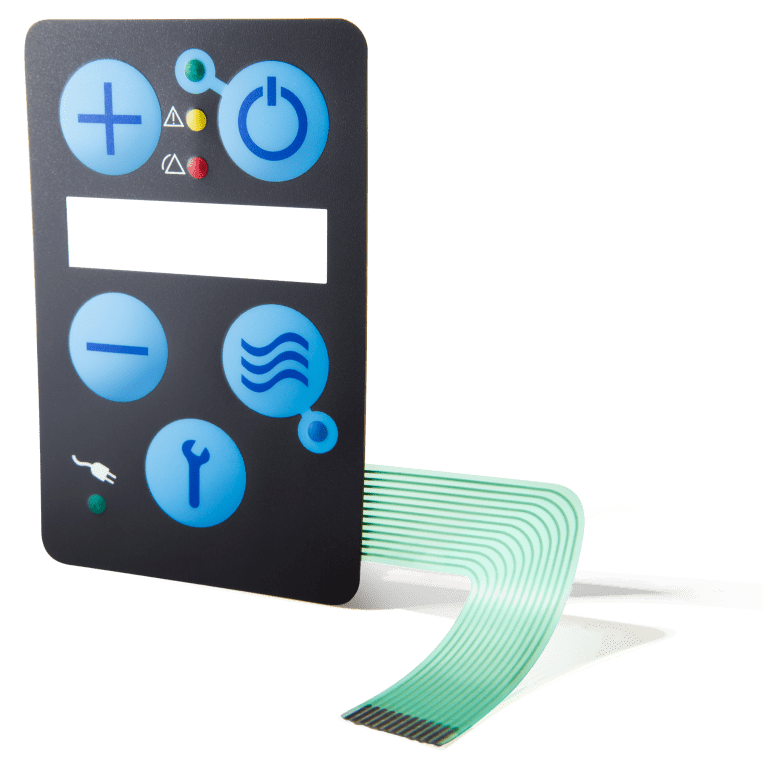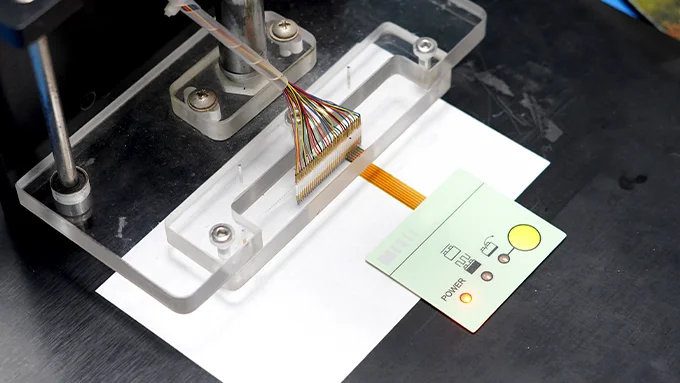How membrane switch enables sustainability in electronic product design
Wiki Article
Comprehending the Relevance of Membrane Layer Switch in Modern Electronics
Membrane buttons are essential elements in modern-day electronic tools. They offer a blend of functionality and design that improves customer interaction. Their light-weight and resilient nature makes them suitable for numerous applications. As sectors progress, the need for customization and progressed attributes grows. Recognizing just how membrane layer switches add to advancement exposes their importance fit the future of electronic devices. What exists in advance for this technology?The Fundamentals of Membrane Switch Technology
Frequently forgotten, membrane button innovation plays an essential function in the modern electronics landscape. These tools, composed of numerous layers, function as user interfaces for various electronic items, varying from family home appliances to medical equipment. A typical membrane switch contains a graphic overlay, a spacer layer, and a circuit layer, which are thoroughly set up to produce a functional interface.When pressure is applied to the overlay, the circuit layer is completed, enabling signals to be sent to the tool. This modern technology is understood for its adaptability, making it possible for customization in functionality, form, and style to fulfill particular individual demands. Additionally, membrane buttons are slim and light-weight, making them suitable for applications where room is a premium. Their longevity and resistance to environmental factors additionally improve their appeal, guaranteeing they can withstand severe problems while preserving performance. On the whole, membrane layer button modern technology is essential to developing reliable and easy to use digital gadgets
Key Benefits of Membrane Layer Changes
Membrane layer switches over offer a number of vital advantages that make them a recommended option in numerous digital applications. Their style enables a compact type aspect, allowing makers to produce lightweight and smooth gadgets. In addition, membrane layer buttons are immune to dust, wetness, and chemicals, which improves their sturdiness and long life in requiring environments. The tactile feedback supplied by these switches can improve individual experience, making them easy and user-friendly to operate.Furthermore, membrane switches can be tailored with varied graphics and colors, permitting special branding possibilities. The manufacturing process is usually economical, particularly for high-volume production, as it minimizes setting up time and simplifies layout. Membrane layer changes call for very little upkeep, contributing to reduced overall functional costs. These benefits highlight their expanding appeal in modern-day electronic devices, where dependability and straightforward user interfaces are essential.
Applications Throughout Different Industries
The versatility of membrane layer switches over allows their extensive fostering throughout numerous industries. In the clinical area, they are frequently utilized in analysis equipment and client surveillance systems, providing a sturdy user interface resistant to contaminants. The automobile industry makes use of membrane buttons for control panel controls, improving user experience with smooth styles that hold up against rough conditions. In customer electronics, they function as control panels for tools such as microwaves and coffee machine, giving a straightforward user interface that is easy to clean. The aerospace field uses membrane buttons in cockpit controls, where integrity and area efficiency are extremely important. Additionally, the commercial industry leverages these buttons in machinery and control systems to ensure durable operation sought after environments. This broad variety of applications emphasizes the versatility of membrane layer buttons, making them integral elements in boosting functionality and user interaction across diverse technical landscapes.Modification and Style Versatility

Future Fads in Membrane Layer Switch Over Growth
Arising trends in membrane switch development indicate a growing emphasis on enhanced functionality and integration with wise innovations. As customer demand for much more advanced digital gadgets boosts, producers are focusing on producing membrane switches that not just offer fundamental operational roles yet likewise include attributes like touch level of sensitivity, backlighting, and haptic feedback.Furthermore, improvements in materials are anticipated to boost toughness and ecological resistance, making membrane layer changes suitable for varied applications in industries such as healthcare, auto, and customer electronic devices. The integration of capacitive touch modern technology is most likely to end up being more widespread, permitting for sleeker styles and improved user interfaces. membrane switch.Additionally, the rise of the Net of Things (IoT) is motivating the growth of membrane layer switches that can connect wirelessly with other devices, enhancing interconnectivity. Generally, the future of membrane button innovation shows up encouraging, driven by advancement and the pursuit of straightforward solutionsRegularly Asked Questions
Just How Do Membrane Layer Changes Contrast to Conventional Mechanical Buttons?
Membrane layer switches, being much more space-efficient and offering a smooth layout, comparison with traditional mechanical buttons that provide responsive responses. The previous typically feature personalized graphics, while the last generally assure toughness and integrity in various applications.What Products Are Generally Used in Membrane Layer Switch Over Manufacturing?
Membrane layer switches are typically generated making use of materials such as polyester, polycarbonate, and printed conductive inks. These materials give versatility, responsiveness, and durability, making them ideal for various applications in electronic tools and user interfaces.Can Membrane Switches Be Repaired or Recycled?
Membrane layer buttons can frequently be fixed, especially if minor issues arise, such as glue failure or surface damage. Nonetheless, complete reuse is normally limited due to wear and possible degradation of materials over time.
Just How Do Ecological Aspects Impact Membrane Switch Over Efficiency?
Environmental aspects, such as direct exposure, temperature level, and humidity to chemicals, substantially influence membrane layer button efficiency. Extreme problems can result in destruction, affecting responsiveness and longevity, eventually compromising the performance of the gadget in different applications.What Is the Typical Life Expectancy of a Membrane Layer Change?
The normal life expectancy of a membrane layer switch normally varies from 1 to 5 million actuations, depending upon factors such as usage regularity, environmental conditions, and the products made use of in manufacturing, affecting longevity and performance long life. A typical membrane switch consists of a visuals overlay, a spacer layer, and a circuit layer, which are carefully set up to create a practical interface - membrane switch.When pressure is used to the overlay, the circuit layer is see finished, enabling signals to be transferred to the gadget. The tactile responses supplied by these buttons can enhance customer experience, making them instinctive and easy to operate.Furthermore, membrane layer buttons can be customized with diverse graphics and shades, permitting for special branding chances. As customer need for extra advanced digital devices increases, producers are focusing on producing membrane changes that not only offer basic operational roles but also integrate attributes like touch level of sensitivity, backlighting, and haptic feedback.Furthermore, developments in products are anticipated to boost resilience Extra resources and environmental resistance, making membrane switches suitable for diverse applications in industries such as healthcare, automotive, and consumer electronics. The combination of capacitive touch innovation is likely to become more prevalent, allowing for sleeker layouts and boosted individual interfaces.Additionally, the surge of the Internet of Points (IoT) is triggering the advancement of membrane changes that can communicate wirelessly with various other tools, improving interconnectivity. Membrane layer buttons, being a lot more space-efficient and providing a sleek style, comparison with standard mechanical buttons that supply tactile feedbackReport this wiki page